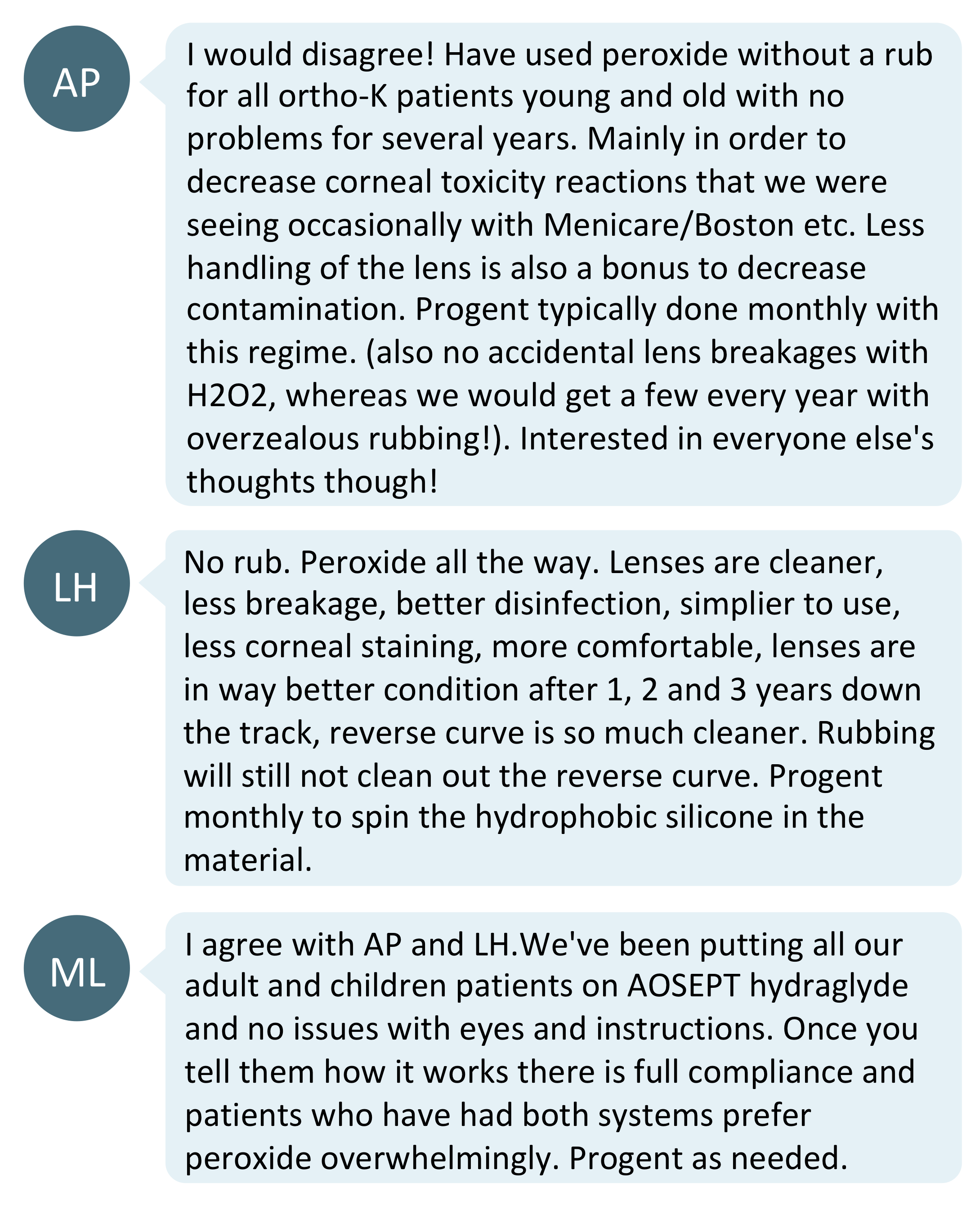When we first fit patients with contact lenses, the standard advice is to rub the contact lens to properly clean them. What should one do when it comes to orthokeratology (orthoK) lenses? OrthoK lenses are designed to have a complex curvature profile, with each parameter playing a crucial part in effecting refractive error correction and ensuring lens stability. Would rubbing the lens cause warpage or deform the lens over time? This post debated the necessity to rub orthok lens while cleaning.

To rub or not to rub? The community was divided on this. Let’s see why.
“It is necessary to rub orthokeratology lenses”

Most commenters agreed with rubbing orthok lenses daily, gently with the fourth or little finger. Physically rubbing the lenses mechanically removes debris and deposits adhering to the lens surface. Multipurpose RGP cleaning solutions generally DO recommend rubbing the lenses when cleaning - for example the Menicon MeniCare Plus multipurpose solution. In addition, many mentioned regular use of Menicon Progent, which is a 30 minute, protein remover and intensive cleaner treatment, for regular use with any type of RGP contact lens.
“It is NOT necessary to rub orthokeratology lenses”

The minority suggested that it is unnecessary to rub the lens. This applies to those who use hydrogen peroxide as the main cleaning agent. Manufacturer instructions for commonly used peroxide systems don't mention a rubbing step. However, skipping the rub step with a peroxide system may mean stubborn deposits aren't removed - read more on this in the next section.
Interestingly, this group of practitioners report no complications associated with the lack of lens rubbing, and less lens breakage than in patients who are rubbing their lenses. They also advocated regular use of Menicon Progent.
What does the literature tells us?
- Cho et al found that hydrogen peroxide and povidone iodine do not remove stubborn deposits (in this case, mascara) from rigid gas permeable lens (RGP) surfaces. However, these stubborn deposits were removed with rubbing.1
- Hydrogen peroxide and povidone iodine solutions can effectively disinfect orthok lenses without rubbing. With RGP cleaners, rubbing the lens can significantly reduce the bacterial load, more so than if one did not rub.2
- There is more to consider regarding orthok hygiene regimes outside of lens cleanliness. Cho et al found that while the awareness of orthoK lens cleanliness was high, lens accessories cleanliness (lens cases, suction holders and tweezers) is poor.3 Jun et al’s questionnaire into the most common areas of noncompliance include exposure to nonsterile solutions, not removing lens deposits with rubbing, and inadequate handwashing.4
Conclusion

Practitioners recommended using hydrogen peroxide or multipurpose solutions for daily cleaning and Menicon Progent every 2-4 weeks for removing protein deposits.
So, is it necessary to rub the lens while cleaning? Rubbing does allow for better removal of stubborn deposits, and a cleaner lens surface. Does it rubbing accelerate lens warpage? The fact is we simply don't know - it hasn't been studied - but a more frequently replaced lens is certainly a better outcome than a less clean lens. It is presumed that gentle rubbing should minimize any significant effect on warpage.
Take home messages:
- Rubbing orthoK lenses whilst cleaning does a better job to remove depositing, regardless of the type of cleaning solution used. Suggest to your patients to use their fourth or little finger to avoid applying too much pressure on the lens, which could potentially influence longer term lens warpage. Adding a regular, additional deep cleaning and protein removal treatment such as Menicon Progent was also advocated.
- Don’t forget to check how patients are maintaining the cleanliness of their lens accessories, such as cases and lens removal suction holders. Chances are that these are often neglected.
- It's important to take the opportunity at each follow up appointment to ask patients to describe and demonstrate their contact lens handling and care procedures, and to reinforce the importance of good hygiene.

About Kimberley
Kimberley Ngu is a clinical optometrist from Perth, Australia, with experience in patient education programs, having practiced in both Australia and Singapore.

About Connie
Connie Gan is a clinical optometrist from Kedah, Malaysia, who provides comprehensive vision care for children and runs the myopia management service in her clinical practice.
This content is brought to you thanks to an unrestricted educational grant from
![]()
References:
- Cho P, Poon HY, Chen CC, Yuon LT. To rub or not to rub? Effective rigid contact lens cleaning. Ophthalmic and Physiological Optics. 2020 Jan;40(1):17-23. (link)
- Itou Y, Miyata N, Kawagoe T, Nobuhisa M, Okada E. Comparison of disinfection efficacies of four contact lens care regimens against pseudomonas aeruginosa on orthokeratology lenses. Investigative Ophthalmology & Visual Science. 2012 Mar 26;53(14):6079. (link)
- Cho P, Boost M, Cheng R. Non-compliance and microbial contamination in orthokeratology. Optometry and Vision Science. 2009 Nov 1;86(11):1227-34. (link)
- Jun J, Zhiwen B, Feifu W, Lili L, Fan L. Level of compliance in Orthokeratology. Eye & Contact Lens. 2018 Sep;44(5):330. (link)











